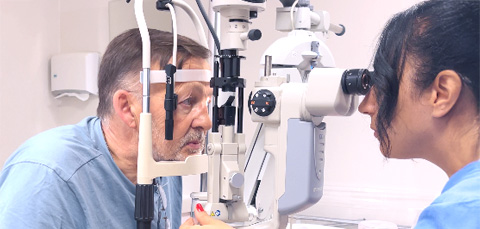Wondering if you should treat both cataracts at once or separately? Learn which option offers faster recovery, balanced vision, and fewer clinic visits—based on your specific eye health needs.
What is Bilateral Cataract Surgery and How Does It Work?
Bilateral cataract surgery is a procedure where cataracts in both eyes are removed during the same surgical session. Cataracts are cloudy areas in the lens of the eye that can cause blurry vision and glare. Removing them restores clearer vision.
During bilateral cataract surgery, the surgeon operates on both eyes sequentially in one sitting. Each eye is cleaned and draped separately. Sterile instruments are used for each eye to reduce the risk of infection. The cloudy lens in each eye is removed and replaced with an artificial intraocular lens (IOL). The procedure usually takes about 15 to 30 minutes per eye.
Patients receive local anesthesia. Sedation may also be used to keep the patient relaxed. Most patients go home the same day. Recovery begins immediately, and vision usually improves within a few days.
Understanding the Surgery Process
Cataract surgery is a routine outpatient procedure. It involves removing the cloudy lens and replacing it with a clear artificial lens.
Before surgery, the eye is measured to choose the correct intraocular lens (IOL). The patient receives local anesthesia to numb the eye. Sedation may be used for comfort.
A small incision is made in the cornea. The surgeon uses ultrasound or laser to break up the cloudy lens. The pieces are gently removed. Then, the IOL is placed into the eye. No stitches are usually needed.
If surgery is done on both eyes at the same time, the team treats each eye as a separate procedure. New sterile tools and drapes are used. This reduces the risk of infection or complications.
The patient rests briefly after the procedure and goes home the same day. Follow-up care starts within the first 24 hours. Most patients see improvement in vision within a few days.
Benefits of Simultaneous Bilateral Cataract Surgery
Simultaneous bilateral cataract surgery offers several advantages for selected patients. It reduces the overall treatment time and helps restore vision in both eyes faster.
Key benefits include:
Single recovery period
Fewer clinic visits
Faster return to daily activities
Balanced vision in both eyes sooner
Less time off work or caregiving responsibilities
Reduced exposure to anesthesia and surgical stress
This approach can be especially helpful for patients with significant cataracts in both eyes or those who have difficulty attending multiple appointments. It may also improve overall patient convenience and satisfaction.
Risks and Considerations in Eye Surgery
Cataract surgery is generally safe. However, like any surgical procedure, it carries some risks. These risks may be slightly higher when both eyes are operated on the same day. Careful patient selection and strict surgical protocols help minimize complications.
Possible risks include:
Infection (endophthalmitis)
Inflammation
Increased eye pressure
Retinal detachment
Lens dislocation
Vision changes or blurring
Double vision
Need for additional surgery
If complications affect both eyes, the impact on vision can be more serious. For this reason, simultaneous bilateral surgery is usually offered only to patients with low risk and good overall health. Surgeons evaluate each patient individually to ensure safety.
What Are the Benefits of Having Both Eyes Treated at the Same Time?
Having both eyes treated at the same time can offer practical and visual benefits, especially for patients with cataracts in both eyes.
The main benefits include:
Quicker improvement in overall vision
Better depth perception and visual balance
Faster return to reading, driving, and daily activities
Fewer days off work or caregiving needs
Reduced number of hospital visits
One-time anesthesia and preparation
This approach helps avoid the period of visual imbalance that can occur when only one eye is treated. It provides faster visual rehabilitation and may improve quality of life sooner.
Advantages Over Sequential Surgery
Simultaneous bilateral cataract surgery offers several advantages compared to sequential surgery, where each eye is treated on different days.
Key advantages include:
Shorter overall treatment timeline
One preoperative preparation and one recovery period
Less time off work or caregiving duties
Fewer hospital or clinic visits
Reduced transportation and travel needs
Consistent visual outcome in both eyes at the same time
Patients often find it more convenient and efficient. It also reduces the stress and discomfort of undergoing two separate surgical sessions.
Potential Recovery Time Reduction
Simultaneous bilateral cataract surgery can shorten the total recovery time. Since both eyes are treated on the same day, patients go through only one healing period instead of two.
This leads to:
Faster return to full vision
Shorter interruption to daily routines
Earlier resumption of work and social activities
Less need for extended use of eye drops and medications
Most patients experience improved vision within a few days. Full healing may take a few weeks, but recovery for both eyes happens at the same time, making the process more efficient.
Cost and Convenience Factors
Simultaneous bilateral cataract surgery can offer cost and convenience advantages for many patients. Treating both eyes in one session may reduce overall healthcare use.
Key factors include:
Fewer preoperative and postoperative appointments
One-time use of surgical facilities and staff
Reduced travel and transportation expenses
Less time away from work or caregiving responsibilities
Lower indirect costs such as missed wages or childcare
For patients paying out of pocket or with limited insurance coverage, fewer visits and a shorter treatment process can help manage costs more effectively.
How Does the Recovery from Cataract Surgery Differ Between One Eye and Two Eyes?
Recovery differs depending on whether one or both eyes are treated at the same time. When only one eye is operated, the untreated eye may still have blurred or distorted vision. This can create temporary visual imbalance.
In simultaneous bilateral surgery:
Both eyes heal together
Visual balance is restored faster
Recovery period is consolidated into one phase
Patients may feel more dependent during the first few days
Reading, driving, and close-up tasks may be limited until both eyes stabilize
Doctors provide specific instructions to protect both eyes and manage healing. Most patients resume normal activities within a few days. Full recovery typically takes a few weeks.
Recovery Time for Simultaneous Bilateral Cataract Surgery
Recovery after simultaneous bilateral cataract surgery is similar to single-eye surgery but occurs in both eyes at the same time. This allows for one combined healing period.
Typical recovery milestones include:
Initial vision improvement within 24 to 48 hours
Most normal activities resumed in a few days
Stabilized vision in about 1 to 2 weeks
Full recovery in 4 to 6 weeks
During recovery, patients use prescribed eye drops to prevent infection and reduce inflammation. Follow-up visits help monitor healing in both eyes. Most patients report clear vision and minimal discomfort after the first few days.
What Types of Cataract Surgery Can Be Performed on Both Eyes?
Several types of cataract surgery can be performed on both eyes, depending on the patient's needs and the surgeon’s recommendation. The main surgical techniques are:
Phacoemulsification: The most common method. Uses ultrasound to break up the lens before removal. Requires a small incision and usually no stitches.
Femtosecond Laser-Assisted Cataract Surgery (FLACS): Uses a laser for precise incisions and lens fragmentation. Offers more accuracy in some cases.
Manual Small Incision Cataract Surgery (MSICS): Involves a slightly larger incision. Often used in complex cases or where advanced technology is not available.
All these techniques can be used for simultaneous bilateral surgery if the patient is a suitable candidate and proper safety protocols are followed.
Choosing the Right Surgical Procedure for You
Choosing the right cataract surgery depends on your eye health, lifestyle, and visual goals. The surgeon evaluates several factors to recommend the best approach.
Key considerations include:
Severity and type of cataracts
General eye condition and overall health
Corneal health and eye pressure
Pre-existing vision problems such as astigmatism
Personal preference and expectations for vision after surgery
Budget and insurance coverage
Your surgeon may suggest standard phacoemulsification or laser-assisted techniques based on your needs. Intraocular lens (IOL) options also vary, from basic monofocal lenses to advanced multifocal or toric lenses. A detailed consultation helps determine the safest and most effective option.
Is Simultaneous Bilateral Cataract Surgery Right for Everyone?
Simultaneous bilateral cataract surgery is not suitable for everyone. Surgeons carefully evaluate each patient to ensure safety and effectiveness.
It may be appropriate for patients who:
Have significant cataracts in both eyes
Are in good general and eye health
Have no major risk factors for complications
Find it difficult to attend multiple appointments
Need faster visual recovery for work or caregiving
It may not be suitable for patients with:
History of eye infections or inflammation
Complex eye conditions like glaucoma or macular degeneration
Increased risk of surgical complications
Poor overall health or unstable medical conditions
A detailed eye exam and consultation are essential to determine eligibility. The surgeon weighs the benefits and risks before recommending this option.





